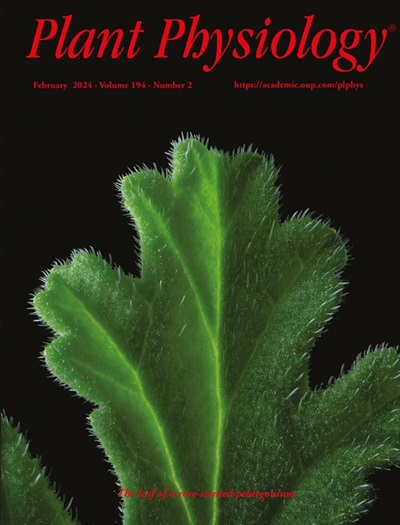细胞色素 b6f 亚基 PetN 的缺失会破坏复合体的稳定性,并严重影响变色龙藻的状态转换
IF 6.5
1区 生物学
Q1 PLANT SCIENCES
引用次数: 0
摘要
细胞色素 b6f 复合物(Cyt b6f)在植物和蓝藻含氧光合作用的线性和循环电子传递过程中发挥着关键作用。Cyt b6f 的四个大亚基负责组织 Cyt b6f 中的电子传递链,在其他细菌的细胞色素 bc1 复合物中也有相应的亚基。Cyt b6f 的四个小亚基是含氧光合作用所独有的,它们的功能仍有待阐明。在此,我们报告了 Anabaena variabilis ATCC 29413 的 petN 突变体(ΔpetN)中,由于小亚基之一 PetN 的缺失,Cyt b6f 失稳,Cyt b6f 大亚基的数量减少到野生型的 20-25%。ΔpetN的氧进化活性约为野生型的30%,加入N,N,N′,N′-四甲基对苯二胺(TMPD)后,氧进化活性可基本恢复。突变体的线性和环状电子传递对 Cyt b6f 抑制剂 2,5-二溴-3-甲基-6-异丙基苯醌(DBMIB)部分不敏感。虽然在正常光照条件下,ΔpetN 中的质醌(PQ)池大部分减少,但突变体的 PSII/PSI 比率大大高于野生型。77K 荧光光谱和室温荧光动力学显示,在有 TMPD 的情况下,ΔpetN 中的状态转换被取消。我们的研究结果有力地表明,蓝藻的状态转换需要 Cyt b6f。本文章由计算机程序翻译,如有差异,请以英文原文为准。
Loss of the cytochrome b6f subunit PetN destabilizes the complex and severely impairs state transitions in Anabaena variabilis
The cytochrome b6f complex (Cyt b6f) plays pivotal roles in both linear and cyclic electron transport of oxygenic photosynthesis in plants and cyanobacteria. The four large subunits of Cyt b6f are responsible for organizing the electron transfer chain within Cyt b6f and have their counterparts in the cytochrome bc1 complex in other bacteria. The four small subunits of Cyt b6f are unique to oxygenic photosynthesis, and their functions remain to be elucidated. Here, we report that Cyt b6f was destabilized by the loss of PetN, one of the small subunits, in a petN mutant (ΔpetN) of Anabaena variabilis ATCC 29413 and that the amount of the large subunits of Cyt b6f decreased to 20-25% of that in the wild-type. The oxygen evolution activity of ΔpetN was approximately 30% of that from the wild-type, and the activity could largely be restored by the addition of N,N,N′, N′-tetramethyl-p-phenylenediamine (TMPD), which functions as an electron carrier and bypasses Cyt b6f. Both linear and cyclic electron transfer of the mutant became partially insensitive to the Cyt b6f inhibitor 2,5-dibromo-3-methyl-6-isopropylbenzoquinone (DBMIB). Although the plastoquinone (PQ) pool was largely reduced in ΔpetN under normal light conditions, the mutant had a substantially higher PSII/PSI ratio than the wild-type. State transitions in ΔpetN were abolished, as revealed by 77K fluorescence spectra and room temperature fluorescence kinetics in the presence of TMPD. Our findings strongly suggest that Cyt b6f is required for state transitions in the cyanobacteria.
求助全文
通过发布文献求助,成功后即可免费获取论文全文。
去求助
来源期刊

Plant Physiology
生物-植物科学
CiteScore
12.20
自引率
5.40%
发文量
535
审稿时长
2.3 months
期刊介绍:
Plant Physiology® is a distinguished and highly respected journal with a rich history dating back to its establishment in 1926. It stands as a leading international publication in the field of plant biology, covering a comprehensive range of topics from the molecular and structural aspects of plant life to systems biology and ecophysiology. Recognized as the most highly cited journal in plant sciences, Plant Physiology® is a testament to its commitment to excellence and the dissemination of groundbreaking research.
As the official publication of the American Society of Plant Biologists, Plant Physiology® upholds rigorous peer-review standards, ensuring that the scientific community receives the highest quality research. The journal releases 12 issues annually, providing a steady stream of new findings and insights to its readership.
 求助内容:
求助内容: 应助结果提醒方式:
应助结果提醒方式:


